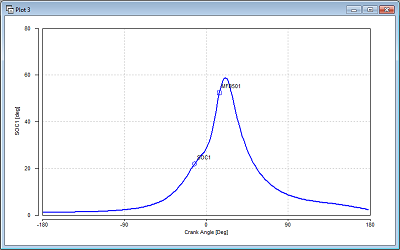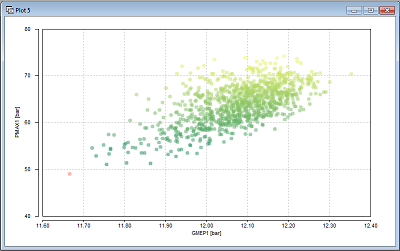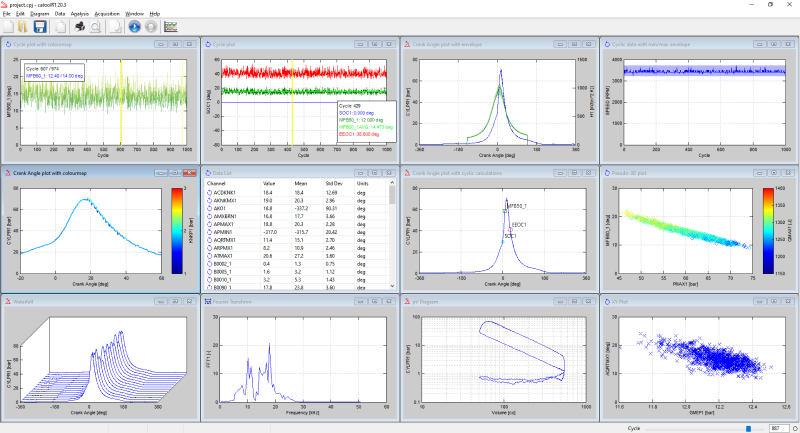
Cylinder Pressure Measurement
catoolRT combines the high speed analysis provided by the open source catool software with the industry leading data acquisition hardware of National InstrumentsTM. It provides a high power, yet low cost, method of cylinder pressure measurement and combustion analysis. catoolRT aims to provide this solution whilst maintaining any existing investment in data acquisition, charge amplifier or pressure transducer hardware.
Cylinder Pressure Analysis
Combustion analysis is an essential tool in allowing those in engine development to maximise performance, driveability, emissions and reliability. By peeking inside the cylinder to determine how and when combustion is initiated and progresses enables changes to be made to both engine hardware and control system parameters. An integrated system allows the user to acquire high quality pressure data, perform extensive thermodynamic and statistical analysis, visualise the information both in realtime and after the fact and exchange data with other common engine development tools.
catoolRT has been in use for over ten years and has customers on all continents. It has been proven in field in test locations such as Pikes Peak, the arctic circle, the Sonoran desert and the Nardò ring. It performs cylinder pressure combustion analysis calculations in-line with AVL IndiComTM. It works both with and without a crank angle encoder. Operating with the production PCM crank angle sensor allow removes the need for an expensive encoder or crank angle processor. catoolRT works with OptrandTM, KistlerTM and AVLTM cylinder pressure sensors including spark plug pressure transducers and Beru production glow plug pressure sensors. CalSyncTM allows fully automatic, time aligned cyclic and crank angle combustion data to be acquired in ETAS INCATM, ATI VISIONTM or Vector CANapeTM.
The system works with both cylinder deactivation and stop-start technologies and can be used without pressure transducers for example to provide OEM type knock detection, replacing "det cans" with proper filtered, windowed knock detection It also enables coil, injector and camshaft analysis allowing the user reverse engineer "black box" PCM mapping. It also facilitates the analysis of intake and exhaust pressures to understand how an engine breathes. catoolRT can analyse existing data from AVL IndiCom, Kistler KiBox, TFX, etc. In addition to very high resolution crank angle data it can acquire CANbus, voltage, thermocouple and digital data for each engine cycle. Advanced features include automatic TDC determination and 720 degree synchronisation, cycle-by-cycle monitoring to trigger warnings or alarms for automatic test cell shutdown and the output of cyclic data on CANbus using VectorTM, KvaserTM or PEAKTM hardware. The system works with a wide range of National Instruments hardware including E/M/X-series, CompactDAQ and PXI
Combustion Analysis System
catoolRT is developed by an experienced engine calibration engineer to work on engine test bed, in-vehicle and for desktop analysis of existing data. The analysis routines are optimised for real time analysis such that next cycle control and engine monitoring are possible. It's low cost and ease of use brings cylinder pressure measurement into the reach of a wider user base.
Cylinder pressure analysis techniques include the calculation of mass fraction burned (MFB) or burn rate analysis, apparent heat release, motored cylinder pressure, indicated mean effective pressure (IMEP), peak knocking pressure and knock integral (MAPO). Cycle, cylinder and engine statistics can be calculated for any parameter. Fourier analysis on both cylinder pressure and knock sensor signals allows the development of knock control filter and response calibrations to be developed. Online calculation of the MFB50 or AI50 angle allows manual or automated calibration of MBT spark timing. Measurement of spark and injector signals can verify correct actuation by the PCM.
Crankangle and Cyclic Analysis
Acquired data is easily exchanged with other software using AVL IFile, Kistler .open, NI TDMS, MATLAB® MAT, A&D CAS and CSV file formats. Existing data that you may already have from other systems can be imported for additional analysis. This also allows catoolRT to complement other combustion systems as a cheaper alternative to AVL Concerto.
Real time cylinder pressure analysis can be streamed at a cyclic basis on CANbus or XCP over Ethernet or CAN. It is also possible to output cyclic analysis as a voltage, frequency or PWM signal, although output in digital CAN or XCP formats would be recommended to avoid loss of accuracy in the digital-to-analogue and subsequent analogue-to-digital conversion.
In-vehicle Cylinder Pressure Measurement
catoolRT works with a wide range of National Instruments data acquisition hardware working with your existing hardware investment. It can be used with systems already developed around DRIVVEN dCATTM, NI-CASTM or Alma HEATITTM.By utilising an embedded PC such as the National Instrument cDAQ-9136 it is possible to log data or generate CANbus results without a laptop, ideal for in-vehicle installation. This makes catoolRT a full replacement for AVL X-ionTM or Kistler KiBox® at a much lower price point. Mounting plates for National Instruments cDAQ hardware and AVL or Kistler charge amplifiers have been developed to allow safe and convenient mounting of the system on the front or rear passenger seat.


